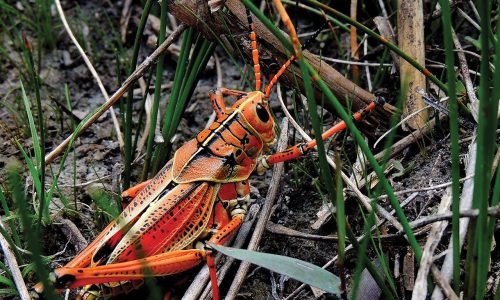By: Kara Tyler-Julian
If you’ve spent time in the natural areas of Florida, chances are you have encountered a large, distinctive insect known as the Eastern Lubber Grasshopper (Romalea guttata), or Lubber for short. The Eastern Lubber Grasshopper is native to Florida and the Southeastern United States and is a member of the family Orthoptera- the grasshoppers, katydids and crickets. These large, colorful grasshoppers are slow-moving and somewhat clumsy in nature. Their slow movement combined with their bright coloration and healthy populations makes them a commonly observed insect in our natural areas and our gardens. This species can be found in many habitats, but it prefers low, wet areas such as wetlands, ditches, and adjacent areas. While the adults are generally a bright coloration of yellow and orange with some shades of red, their coloration is variable and they can even occur in a dark black form, especially in North Florida. Their bright coloration is an example of aposematic coloration, a warning to predators that they are inedible due to toxins contained in their bodies. As an additional defense against predation, these grasshoppers can emit a distasteful and odiferous frothy substance from their spiracles.
Lubbers are a polyphagous insect, which means that rather than specializing on eating one species or family of plants, these insects feed on a wide range of plant species. They have been documented to feed on over 100 species of plant, but they seem to prefer plants in the lily family, as many gardeners can attest. The toxins that the lubber grasshoppers produce come from the plants that they consume and the variety of plants in their diet leads to a variety of toxins in their bodies. Females deposit the eggs underground by digging a small hole up to 5 cm deep and then laying. The female will lay clusters of eggs in approximately 3-5 pods with each pod having around 60 eggs in it. The eggs are deposited in the summer and will hatch after 6-8 months, requiring at least 3 months of cool weather in order to hatch. When the eggs hatch, the young grasshoppers that emerge are called nymphs and they are visibly different from the adults, appearing black with either red or yellow stripes. Nymphs can usually be seen beginning to emerge in the spring through early summer.
The lubber nymphs are gregarious in nature and can often be seen in large groups, defoliating plants. As they grow and develop through their 5-6 instars, they will gradually decrease in number as they disperse and are consumed by predators. While the internet is rife with misinformation about these insects having no natural predators, numerous native animals have been documented feeding on them through photographs. The loggerhead shrike is well known to feed on the lubbers by impaling them and leaving them for some time to allow the toxins to break down, but other animals have been observed consuming them without this step. The predators of the lubbers include, but are not limited to: wasps, spiders, wheel bugs, Northern cardinals, blue jays, blue birds, Mississippi kites, swallow-tailed kits, leopard frogs, box turtles, Eastern gray squirrels and fox squirrels.
While many gardeners are quick to kill every lubber grasshopper that they see, keep in mind that this is a native insect and a natural part of the local ecosystem. Try to plant native plants and stay away from lilies and you won’t have much trouble from these creatures. Remember to minimize the use of pesticides because these products can affect more than just the one species you are trying to get rid of, and just try to appreciate the beautiful diversity of life in your yard when you spot these land lobsters. If you really want them out of your yard, try grabbing them and tossing them into your neighbor’s yard or releasing them into a nearby natural area.








